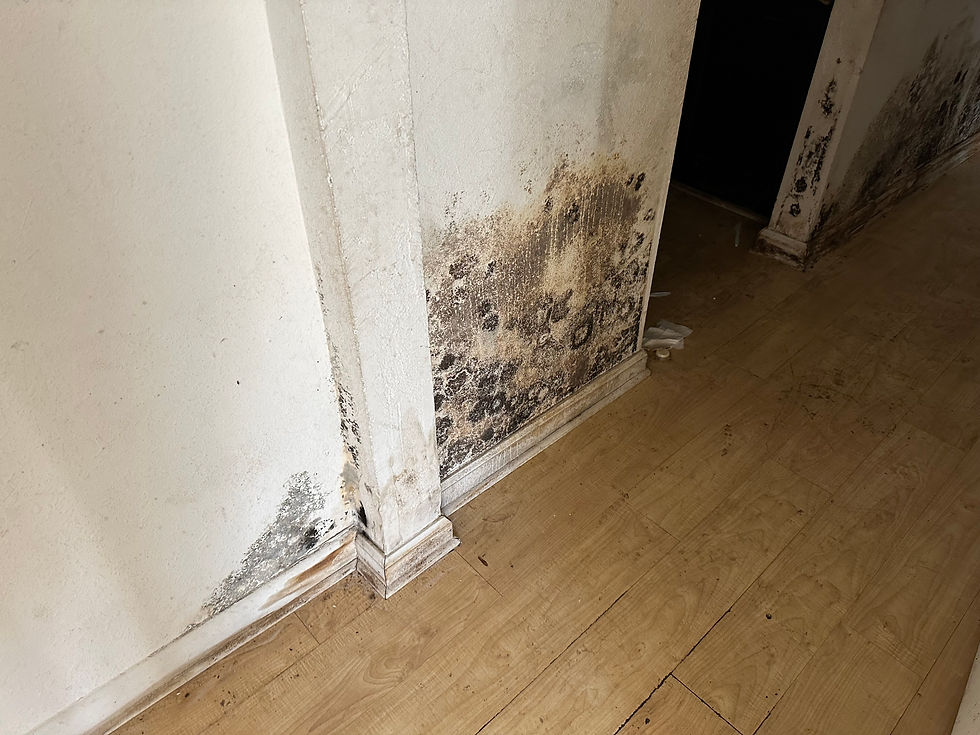Mold Growth in Carolina’s Summer Heat: What Every Homeowner Should Know
- Steve Rebl

- Jul 2
- 3 min read
Why Summer Is Prime Time for Mold in the Carolinas
Summer in the Carolinas isn’t just about sunny afternoons and backyard barbecues—it’s also peak season for mold growth. The high humidity, frequent storms, and warm temperatures create ideal conditions for mold spores to thrive indoors.
Ignoring mold isn’t just unsightly—it can damage your property, impact indoor air quality, and even pose health risks for sensitive individuals. Let’s break down why mold loves Carolina’s summer heat, how to spot the warning signs early, and what you can do to protect your home.
How Fast Can Mold Grow in Summer?
Warmth and moisture act like fertilizer for mold. Under ideal conditions (think 85°F+ with high humidity), mold can begin to colonize within 24–48 hours after water exposure.
Timeline of Mold Growth:
0–24 hours: Mold spores land on damp surfaces.
24–48 hours: Spores germinate and begin spreading roots (hyphae).
48–72 hours: Visible growth appears on walls, ceilings, or floors.
1 week+: Large colonies develop, releasing allergens and potentially mycotoxins.
Unchecked, this growth can destroy drywall, flooring, insulation, and personal belongings—leading to costly restoration.
Common Summer Mold Hotspots in Homes
Where does mold typically show up? Look for these vulnerable areas:
Bathrooms with poor ventilation
Kitchens (under sinks, behind appliances)
Basements and crawl spaces
Around HVAC ductwork and vents
Attics with roof leaks
Walls or ceilings after storm damage
Warning Signs of Mold in Your Home
You don’t need to see giant black patches to know there’s a problem. Watch (and smell) for these early signs:
Persistent musty or earthy odor
Discoloration or staining on walls/ceilings
Peeling paint or bubbling wallpaper
Recent water leaks or flooding
Allergy-like symptoms indoors (coughing, sneezing, itchy eyes)
Pro Tip: Use a simple humidity monitor. Keeping indoor humidity below 60% is one of the easiest ways to discourage mold growth.
Mold Prevention Tips for Carolina Homeowners
While you can’t eliminate all mold spores (they’re everywhere!), you can make your home less inviting for growth:
Fix leaks immediately (roof, plumbing, foundation)
Run dehumidifiers in damp spaces
Ventilate bathrooms and kitchens with fans
Keep gutters clean and directed away from your foundation
Insulate pipes to prevent condensation
Use mold-resistant products in renovations
When to Call a Professional Mold Remediator
DIY is fine for tiny surface spots (<10 sq ft) on non-porous surfaces. But for bigger or hidden issues, professional help is critical.
Visible mold covering large areas
Mold inside walls or HVAC systems
Mold after significant water damage
Recurring mold despite cleaning
Concerns about health impacts (asthma, immune issues)
At Edmondson Restoration, our certified mold remediation team follows strict industry protocols to safely remove mold, repair damage, and prevent future growth.
Our Mold Remediation Process
When you choose Edmondson Restoration, you get:
Thorough inspection & moisture mapping
Containment of affected areas
HEPA filtration and negative air setup
Safe removal of contaminated materials
Cleaning and disinfection of surfaces
Drying and humidity control
Guidance to prevent future mold
Final Thoughts
Don’t let Carolina’s summer heat turn your home into a breeding ground for mold. With prompt attention, smart prevention, and professional help when needed, you can protect your property and your health.
Ready for a Mold Inspection?
Contact Edmondson Restoration today for a free professional assessment. Our local team is here 24/7 to keep your home safe, healthy, and mold-free.






Comments